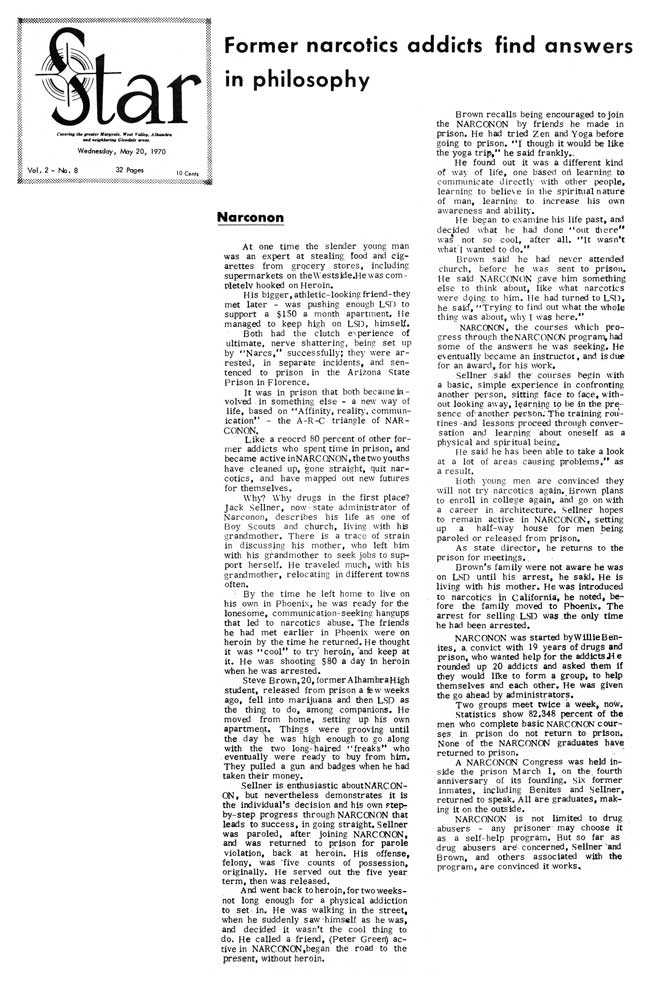Former Addicts Find Answers in Narconon
Star: Weds., May 20, 1970

At one time the slender young man was an expert at stealing food and cigarettes from grocery stores, including supermarkets on the Westside. He was completely hooked on Heroin.
His bigger, athletic-looking friend–they met later–was pushing enough LSD to support a $150 a month apartment. He managed to keep high on LSD, himself.
Both had the clutch experience of ultimate, nerve shattering, being set up by “Narcs,” successfully; they were arrested, in separate incidents, and sentenced to prison in the Arizona State Prison in Florence.
It was in prison that both became involved in something else–a new way of life, based on “Affinity, reality, communication”–the A-R-C triangle of NARCONON.
Like a record 80 percent of other former addicts who spent time in prison, and became active in NARCONON, the two youths have cleaned up, gone straight, quit narcotics, and have mapped out new futures for themselves.
Why? Why drugs in the first place? Jack Sellner, now state administrator of Narconon, describes his life as one of Boy Scouts and church, living with his grandmother. There is a trace of strain in discussing his mother, who left him with his grandmother to seek jobs to support herself. He traveled much with his grandmother, relocating in different towns often.
By the time he left home to live on his own in Phoenix, he was ready for the lonesome, communication-seeking hangups that led to narcotics abuse. The friends he had met earlier in Phoenix were on heroin by the time he returned. He thought it was “cool” to try heroin, and keep at it. He was shooting $80 a day in heroin when he was arrested.
Steve Brown, 20, former Alhambra High student, released from prison a few weeks ago, fell into marijuana and then LSD as the thing to do among companions. He moved from home, setting up his own apartment. Things were grooving until the day he was high enough to go along with the two long-haired “freaks” who eventually were ready to buy from him. They pulled a gun and badges when he had taken their money.
Sellner is enthusiastic about NARCONON, but nevertheless demonstrates it is the individual’s decision and his own step-by-step progress through NARCONON that leads to success in going straight. Sellner was paroled, after joining NARCONON, and was returned to prison for parole violation, back at heroin. His offense, felony, was five counts of possession, originally.
He served out the five year term, then was released.
And went back to heroin, for two weeks-not long enough for a physical addiction to set, in. He was walking in the street, when he suddenly saw himself as he was, and decided it wasn’t the cool thing to do. He called a friend, (Peter Green) active in NARCONON, began the road to the present, without heroin.
Brown recalls being encouraged to join the NARCONON by friends he made in prison. He had tried Zen and Yoga before going to prison. “I though it would be like the yoga trip,” he said frankly.
He found out it was a different kind of way of life, one based on learning to communicate directly with other people, learning to believe in the spiritual nature of man, learning to increase his own awareness and ability.
He began to examine his life past, and decided what he had done,“out there” was not so cool, after all. “It wasn’t what I wanted to do.”
Brown said he had never attended church, before he was sent to prison. He said NARCONON gave him something else to think about, like what narcotics were doing to him. He had turned to LSD, he said, “Trying to find out what the whole thing was about, why I was here.”
NARCONON, the courses which progress through the NARCONON program, had some of the answers he was seeking. He eventually became an instructor, and is due for an award, for his work.
Sellner said the courses begin with a basic, simple experience in confronting another person, sitting face to face, without looking away, learning to be in the presence of another person. The training routines and lessons proceed through conversation and learning about oneself as a physical and spiritual being.
He said he has been able to take a look at a lot of areas causing problems,” as a result.
Both young men are convinced they will not try narcotics again. Brown plans to enroll in college again, and go on with a career in architecture. Sellner hopes to remain active in NARCONON, setting up a half-way house for men being paroled or released from prison.
As state director, he returns to the prison for meetings.
Brown’s family were not aware he was on LSD until his arrest, he said. He is living with his mother. He was introduced to narcotics in California, he noted, before the family moved to Phoenix. The arrest for selling LSD was the only time he had been arrested.
NARCONON was started by Wi1lie Benitez, a convict with 19 years of drugs and prison, who wanted help for the addicts. He rounded up 20 addicts and asked them if they would like to form a group, to help themselves and each other. He was given the go ahead by administrators.
Two groups meet twice a week, now.
Statistics show 82.348 percent of the men who complete basic NARCONON courses in prison do not return to prison. None of the NARCONON graduates have returned to prison.
A NARCONON Congress was held inside the prison March 1, on the fourth anniversary of its founding. Six former inmates, including Benitez and Sellner, returned to speak. All are graduates, making it on the outside.
NARCONON is not limited to drug abusers - any prisoner may choose it as a self-help program. But so far as drug abusers are, concerned, Sellner and Brown, and others associated with the program, are convinced it works.
Related Articles: